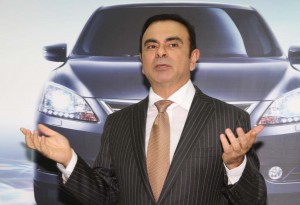The strategic partnership between Renault and Nissan has been credited with saving the once-foundering Japanese maker and, more recently, helping the French side of the alliance hold its own during the European economic crunch. Now, say the two makers, they achieved record “synergies” for the 2012 model-year.
By working together on everything from parts distribution to product development, the Renault-Nissan Alliance reports it generated 2.69 billion Euros in synergies last year, a 54% jump from the 1.75 billion achieved in 2012.
“Synergies and greater economies of scale allow Renault and Nissan to compete in an elite tier of the world’s top automakers globally,” said Christian Mardrus, Renault-Nissan Alliance Managing Director for Logistics and the Office of the CEO. “We expect to generate even more synergies going forward, particularly in emerging markets such as Brazil, Russia, India and China.”
The makers note that the latest figures don’t carry over savings – or synergies – achieved in earlier years. And they note that while some patterns continue, others are shifting as the Renault-Nissan Alliance evolves to reflect changes in the global automotive business.
For example, the synergies achieved by the alliance increasingly come from Asia and from emerging markets such as China, where the two makers share assembly and powertrain plants. The same is true in India, where they operate out of a single plant in Chennai capable of producing 400,000 Renault and Nissan vehicles annually. It is the Alliance’s single-largest platform-sharing project.
That said, shared purchasing operations remained the single largest contributor to the partnership, credited for 851 million Euros in synergies. That was followed by powertrain, at 709 million, and vehicle engineering, at 546 million.
A critical move for the Alliance came last year with the launch of a new vehicle platform called the Common Module Family, or CMF. It is expected to bring the two companies even closer together as it expands the range of products and parts they will share. The CMF, noted an Alliance release, “is expected to generate an average 30-40% reduction in entry cost per model and a 20-30% reduction in parts cost.”
Formed in 1999, the Renault-Nissan Alliance was a significant shift away from the conventional wisdom of the day which as often as not saw one maker buy out another – or limit strategic partnerships to just a few, select projects. Together, the French and Japanese maker now account for nearly 10% of the world automotive market, with combined 2012 sales of 8.1 million vehicles.
The Alliance, meanwhile, has grown to include Daimler AG, although the German maker is limiting its involvement to a more traditional, project-based partnership. Nonetheless, the relationship has been growing and now includes several common vehicle projects. Renault, for example, is taking the lead on a vehicle program that will yield it a new version of the Twingo minicar that Daimler will market as the Smart forfour. Meanwhile, the German Mercedes-Benz brand’s new compact platform will be shared with some new Infiniti models.
There is little doubt that the Alliance has become crucial to both Renault and Nissan. The French automaker is struggling to avoid the sharp decline suffered by its Paris-based rival, PSA Peugeot Citroen, which has plunged deeply into the red as a result of Europe’s deep car slump. Nissan has had its own headaches, including a sharp decline in sales in China following a political dispute between that country and Japan.
That was a key reason why Nissan’s results for the 2012 fiscal year, which ended on March 31, rose a modest 0.3% to $3.4 billion. By comparison, Toyota earnings jumped threefold to $10.2 billion last year.
Nonetheless, stockholders and board members were apparently impressed enough to confirm that Carlos Ghosn, the joint CEO for both members of the Renault-Nissan Alliance will be sticking around for at least several more years beyond 2014, when his contract was set to expire. Ghosn also confirmed – and defended – a $10.1 million paycheck for last year. While that makes him one of Japan’s highest-paid executives, he asserted the fee was “average” for his duties in the auto industry.
While Ghosn described 2012 as a “year of progress” for Nissan during the maker’s annual shareholders meeting last week, he insisted the maker stands to report substantial sales growth in 2013, in part as sales rebound in China.


These alliances all sound good and initially may look good on paper… We’ll see how this one works out long term.